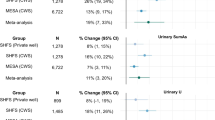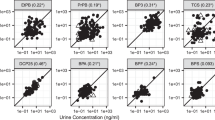Abstract
Environmental factors, such as storage time, frequency of bottle reuse and temperature, have been shown to facilitate antimony (Sb) leaching from water- and food-packaging materials. The globally escalating consumption of water packaged in Sb-containing bottles, such as that of polyethylene terephthalate (PET), could increase human daily Sb doses. This study set out to investigate the relationship between drinking-water source, use characteristics, and urinary Sb concentrations (U-Sb) accompanied with survey responses of a healthy (n=35) Cypriot participant pool. One spot urine sample was collected during administration of questionnaire, while a second spot urine sample was collected from the same individual about 7 days later. Urinary and water Sb concentrations were measured with an inductively coupled plasma mass spectrometer. Survey responses showed that bottled water summed over various volumes and plastic types, such as polycarbonate and PET contributed to an average 61% of daily water consumption. Water sources such as tap, mobile stations (explained in a following section), and well water contributed to 24%, 14%, and 2% of an individual’s daily water consumption pattern, respectively. Average daily potable water use of both bottled and tap water by individuals consisted of 65% drinking-water, while the remaining 35% was water used for preparing cold and hot beverages, such as, tea, coffee, and juices. A significant (P=0.02) association between per capita water consumption from PET bottles and urinary creatinine-unadjusted concentrations was observed, but this relationship did not remain after inclusion of covariates in a multivariate regression model. In the creatinine-adjusted regression model, only gender (female) was a significant (P<0.01) predictor of U-Sb, after adjusting for several covariates. It is proposed that consumption data collection on various water uses and sources among individuals could perhaps decrease the uncertainty associated with derivations of acceptable daily Sb intakes.
This is a preview of subscription content, access via your institution
Access options
Subscribe to this journal
Receive 6 print issues and online access
$259.00 per year
only $43.17 per issue
Buy this article
- Purchase on Springer Link
- Instant access to full article PDF
Prices may be subject to local taxes which are calculated during checkout

Similar content being viewed by others
Abbreviations
- BMI:
-
body mass index
- CB:
-
cold beverage(s)
- HB:
-
hot beverage(s)
- ICP-MS:
-
inductively coupled plasma mass spectrometer
- MCL:
-
maximum contaminant level
- OEHHA:
-
Office of Environmental Health Hazard Assessment
- PC:
-
polycarbonate
- PET:
-
polyethylene terephthalate
- PHG:
-
public health goal
- PP:
-
polypropylene
- PW:
-
plain drinking-water
- Sb:
-
antimony
- SRM:
-
standard reference material(s)
- U-Sb:
-
urinary antimony
References
Belzile N, Chen YW, Filella M . Human exposure to antimony: I. Sources and intake. Crit Rev Env Sci Technol 2011; 41: 1309–1373.
Nriagu JO . Global metal pollution. Poisoning the biosphere? Environ 1990; 32: 7–33.
Filella M, Williams PA, Belzile N . Antimony in the environment: knowns and unknowns. Environ Chem 2009; 6: 95–105.
Iijima A, Sato K, Yano K, Kato M, Kozawa K, Furuta N . Emission factor for antimony in brake abrasion dusts as one of the major atmospheric antimony sources. Env Sci Technol 2008; 42: 2937–2942.
Crommentuijn T, Polder MD, van de Plasche EJ . Maximum permissible concentrations and negligible concentrations of metals, taking background concentrations into account, RIVM Report No. 601 501 001 National Institute of Public Health and the Environment: Bilthoven, Netherlands, 1997.
Filella M, Belzile N, Chen YW . Antimony in the environment: a review focused on natural waters I. Occurrence. Earth-Sci Rev 2002; 57: 125–176.
Hammel W, Debus R, Steubing L . Mobility of antimony in soil and its availability to plants. Chemosphere 2000; 41: 1791–1798.
Waheed S, Siddique N . Evaluation of dietary status with respect to trace element intake from dry fruits consumed in Pakistan: a study using instrumental neutron activation analysis. Int Food Sci Nutr 2009; 60: 333–343.
Nriagu JO, Pacyna JM . Quantitative assessment of worldwide contamination of air, water and soils by trace metals. Nature 1988; 333: 134–139.
McCallum RI . Occupational exposure to antimony compounds. J Environ Monit 2005; 7: 1245–1250.
Shotyk W, Krachler M, Chen B . Contamination of Canadian and European bottled waters with antimony from PET containers. J Environ Monit 2006; 8: 288–292.
USAC (United States Antimony Corporation). Antimony uses and formulations. http://www.usantimony.com/uses.htm (accessed 22 June 2012).
CIPET (Central Institute of Plastics and Engineering Technology). Plastics Industry—Statistics 2010. http://cipet.gov.in/plastics_statistics.html (accessed 22 June 2012).
Rodwan JG . Bottled Water 2009. International Bottled Water Association 2010. http://www.bottledwater.org/files/2009BWstats.pdf (accessed 22 June 2012).
Shotyk W, Krachler M . Contamination of bottled waters with antimony leaching from polyethylene terephthalate (PET) increases upon storage. Env Sci Technol 2007; 41: 1560–1563.
Westerhoff P, Prapaipong P, Shock E, Hillaireau A . Antimony leaching from polyethylene terephthalate (PET) plastic used for bottled drinking water. Water Res 2008; 42: 551–556.
Andra SS, Makris KC, Shine JP . Frequency of use controls chemical leaching from drinking-water containers subject to disinfection. Water Res 2011; 45: 6677–6687.
Andra SS, Makris KC, Shine JP, Lu C . Co-leaching of brominated compounds and antimony from bottled water. Environ Int 2012; 38: 45–53.
Tukur A, Sharp L, Stern B, Tizaoui C, Benkreira H . PET bottle use patterns and antimony migration into bottled water and soft drinks: the case of British and Nigerian bottles. J Environ Monit 2012; 14: 1237–1247.
EU (European Union). Council Directive 98/83/EC 1998. http://eur-lex.europa.eu/LexUriServ/LexUriServ.do?uri=CELEX:31998L0083:EN:HTML (accessed 22 June 2012).
USEPA (United States Environmental Protection Agency). US Environmental Protection Agency. Drinking Water Contaminants: National Primary Drinking Water Regulations 2002. http://water.epa.gov/drink/contaminants/index.cfm (accessed 22 June 2012).
Health Canada. Health Canada 8.1 Metals and Trace Elements. 8.1.1 Antimony (CASRN 7440-36-0). 1998. http://www.hc-sc.gc.ca/ewh-semt/pubs/contaminants/chms-ecms/section8-eng.php#n8_1 (accessed 22 June 2012).
Keresztes S, Tatar E, Mihucz VG, Virag I, Majdik C, Zaray G . Leaching of antimony from polyethylene terephthalate (PET) bottles into mineral water. Sci Total Environ 2009; 407: 4731–4735.
Hansen HR, Pergantis SA . Detection of antimony species in citrus juices and drinking water stored in PET containers. J Anal At Spectrom 2006; 21: 731–733.
Krachler M, Shotyk W . Trace and ultratrace metals in bottled waters: survey of sources worldwide and comparison with refillable metal bottles. Sci Total Environ 2009; 407: 1089–1096.
Jenkins RO, Craig PJ, Goessler W, Irgolic KJ . Antimony leaching from cot mattresses and sudden infant death syndrome (SIDS). Hum Exp Toxicol 1998; 17: 138–139.
Potkonjak V, Pavlovich M . Antimoniosis—A particular form of pneumoconiosis. 1. Etiology, clinical and x-ray findings. Int Arch Occup Environ Health 1983; 51: 199–207.
Brieger H, Semisch CW, Stasney J, Piatnek DA . Industrial antimony poisoning. Ind Med Surg 1954; 23: 521–523.
White GP, Mathias CGT, Davin JS . Dermatitis in workers exposed to antimony in a melting process. J Occup Environ Med 1993; 35: 392–395.
Belyaeva AP . The effect of antimony on reproduction. Gig Tr Prof Zabol J 1967; 11: 32–37.
Sundar S, Chakravarty Y . Antimony toxicity. Int J Environ Res Public Health 2010; 7: 4267–4277.
Jones RD . Survey of antimony workers-mortality 1961–1992. Occup Environ Med 1994; 51: 772–776.
Cavallo D, Iavicoli I, Setini A, Marinaccio A, Perniconi B, Carelli G et al. Genotoxic risk and oxidative DNA damage in workers exposed to antimony trioxide. Environ Mol Mutagen 2002; 40: 184–189.
IARC (International Agency for Research on Cancer). Antimony Trioxide and Antimony Trisulfide. IARC: Lyon, France, 1989 pp 291–305.
OEHHA (Office of Environmental Health Hazard Assessment). California Environmental Protection Agency). Public Health Goal for Antimony in Drinking Water (Draft), Office of Environmental Health Hazard Assessment California Environmental Protection Agency: Oakland/Sacramento, CA, 2009. http://oehha.ca.gov/water/phg/pdf/PHGAntimonyD072309.pdf (accessed 22 June 2012).
Sax L . Polyethylene terephthalate may yield endocrine disruptors. Environ Health Perspect 2010; 118: 445–448.
CDC (Centers for Disease Control and Prevention). National Health and Nutrition Examination Survey 2007–2008. Urine Heavy Metals. Centers for Disease Control and Prevention. 2009. http://www.cdc.gov/nchs/nhanes/nhanes2007-2008/UHM_E.htm#URXUSB (accessed 21 October 2012).
ATSDR (Agency for Toxic Substances and Disease Registry). Toxicological Profile for Antimony and Compounds 1992. http://www.atsdr.cdc.gov/toxprofiles/tp23.pdf (accessed 22 June 2012).
Amarasiriwaredena CJ, Lupoli N, Potula V, Korrick S, Hu H . Determination of the total arsenic concentration in human urine by inductively coupled plasma mass spectrometry (ICP-MS): a comparison of the accuracy of three analytical methods. Analyst 1998; 123: 441–446.
CDC (Centers for Disease Control and Prevention). Second National Report on Human Exposure to Environmental Chemicals. 2003; 26–28. http://www.jhsph.edu/research/centers-and-institutes/center-for-excellence-in-environmental-health-tracking/Second_Report.pdf (accessed 21 October 2012).
Suzuki J, Katsuki Y, Ogawa H, Suzuki K, Matsumoto H, Yasuda K . Concentration of trace elements in bottled drinking water. J Food Hyg Soc 2000; 41: 387–396.
Guler C, Alpaslan M . Mineral content of 70 bottled water brands sold on the Turkish market: assessment of their compliance with current regulations. J Food Compos Anal 2009; 22: 728–737.
Rice DC, Lincoln R, Martha R, Parker J, Pote L, Xing K et al. Concentration of metals in blood of Maine children 1–6 years old. J Exposure Sci Environ Epidemiol 2010; 20: 634–643.
Edgren G, Liang L, Adami HO, Chang ET . Enigmatic sex disparities in cancer incidence. Eur J Epidemiol 2012; 27: 187–196.
USEPA (United States Environmental Protection Agency). Antimony. Drinking Water Health Advisory. Office of Water, U.S. Environmental protection Agency: Washington, DC, April 1992a. http://water.epa.gov/drink/contaminants/basicinformation/antimony.cfm (accessed 22 June 2012).
USEPA (United States Environmental Protection Agency). Drinking water criteria document for antimony (final report). US Environmental protection Agency: Washington, DC, January 1992b. http://nepis.epa.gov/Exe/ZyPURL.cgi?Dockey=901H0800.txt (accessed 22 June 2012).
USEPA (United States Environmental Protection Agency). National Primary Drinking Water Regulations. Antimony. Office of Water, US Environmental Protection Agency: Washington, DC, 1995. http://nepis.epa.gov/Exe/ZyPURL.cgi?Dockey=9100PO2E.txt (accessed 22 June 2012).
World Health Organization (WHO). Antimony in Drinking-water. Background document for development of WHO guidelines for drinking-water quality. Available at: Quality 2003. http://www.who.int/water_sanitation_health/dwq/chemicals/antimony.pdf (accessed 22 June 2012).
Mayerhofer CJC . Physiologische, pathologisch-anatomische und pathologisch-chemische Wirkungen der Antimonial praparate auf den gesunden menschlichen und thierischen Organismus. [The physiological, pathological anatomy and pathological chemistry of antimony preparations on the health of mankind and animal organisms]. Heller’s Archiv fur Physiologie und Pathologie Chemie und Mikroskopie III Jahrgang 1846, 97–356.
Choe SY, Kim SJ, Kim HG, Lee JH, Choi Y, Lee H et al. Evaluation of estrogenicity of major heavy metals. Sci Total Environ 2003; 312: 15–21.
Gebel T . Arsenic and antimony: comparative approach on mechanistic toxicology. Chem Biol Interact 1997; 107: 131–144.
Martin RR, Shotyk WS, Naftel SJ, Ablett JM, Northrup P . Speciation of antimony in polyethylene terephthalate bottles. X-Ray Spectrom 2010; 9: 257–259.
Frezard F, Demicheli C, Ribeiro RR . Pentavalent antimonials: new perspectives for old drugs. Molecules 2009; 14: 2317–2336.
Patriarca M, Menditto A, Rossi B, Lyon TDB, Fell GS . Environmental exposure to metals of newborns, infants and young children. Microchem J 2000; 67: 351–361.
Acknowledgements
We would like to thank Mr. Nicola Lupoli, Drs Innocent Jayawardene and Chitra Amarasiriwardena at the Trace Metals Laboratory, Harvard School of Public Health, for providing assistance and guidance with the ICP-MS.
Disclaimer
The observations and speculations in this article represent those of the authors, and do not necessarily reflect the views of the participating organizations, viz., Cyprus University of Technology, Limassol, Cyprus; University of Arizona, Tucson, USA; and the Harvard School of Public Health, Boston, USA.
Author information
Authors and Affiliations
Corresponding author
Ethics declarations
Competing interests
The authors declare no conflict of interest.
Additional information
Supplementary Information accompanies the paper on the Journal of Exposure Science and Environmental Epidemiology website
Supplementary information
Rights and permissions
About this article
Cite this article
Makris, K., Andra, S., Herrick, L. et al. Association of drinking-water source and use characteristics with urinary antimony concentrations. J Expo Sci Environ Epidemiol 23, 120–127 (2013). https://doi.org/10.1038/jes.2012.104
Received:
Accepted:
Published:
Issue Date:
DOI: https://doi.org/10.1038/jes.2012.104



